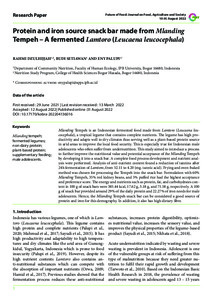| dc.date.accessioned | 2022-09-01T06:37:45Z | |
| dc.date.available | 2022-09-01T06:37:45Z | |
| dc.date.issued | 2022-08-31 | |
| dc.identifier | doi:10.17170/kobra-202204136016 | ger |
| dc.identifier.uri | http://hdl.handle.net/123456789/14117 | |
| dc.language.iso | eng | |
| dc.rights | Namensnennung 4.0 International | * |
| dc.rights.uri | http://creativecommons.org/licenses/by/4.0/ | * |
| dc.subject | fermented legumes | eng |
| dc.subject | non-dairy protein | eng |
| dc.subject | ion | eng |
| dc.subject | plant based protein | eng |
| dc.subject | supplementary feeding | eng |
| dc.subject | young men | eng |
| dc.subject.ddc | 580 | |
| dc.subject.ddc | 630 | |
| dc.title | Protein and iron source snack bar made from Mlanding Tempeh – A fermented Lamtoro (Leucaena leucocephala) | eng |
| dc.type | Aufsatz | |
| dcterms.abstract | Mlanding tempeh is an Indonesian fermented food made from Lamtoro (Leucaena leucocephala), a tropical legume that contains complete nutrients and has high productivity and ability to adapt to dry climates. This traditional treatment seems improve its nutritional value, particularly the protein profile. However the short shelf life and low acceptance hinder this food to support community nutrition. This study introduced an effort to process this indigenous fermented legume into a snack bar which has better acceptance and nutritional value. A complete food process development and nutrient analysis have been performed for producing and profiling this bar. Analysis on anti-nutrient content reveals a reduction of tannins after 24h fermentation of Lamtoro, from 52.11 to 4.20 (mg. tannic acid). Frying and oven were chosen for processing the Tempeh into a snack bar with better acceptance. Formula with 60% Mlanding tempeh, 35% red beans and 5% rice popcorn was chosen as the highest acceptance and preference. The content of energy and nutritional nutrients (protein, fat, and carbohydrates) in 100 g of snack bars are 385.44 kcal, 17.62 g, 3.18 g and 71.58 g, respectively. 100 g of the snack bar might provide 29% of daily protein need. Mlanding tempeh snack bar is high in fiber, a source of protein and iron minerals and low in fat. | eng |
| dcterms.accessRights | open access | |
| dcterms.creator | Dzulhijjah, Rahmi | |
| dcterms.creator | Setiawan, Budi | |
| dcterms.creator | Palupi, Eny | |
| dc.subject.swd | Indonesien | ger |
| dc.subject.swd | Tempeh | ger |
| dc.subject.swd | Hülsenfrüchtler | ger |
| dc.subject.swd | Milchproteine | ger |
| dc.subject.swd | Pflanzliche Proteine | ger |
| dc.subject.swd | Heranwachsender | ger |
| dc.subject.swd | Fermentiertes Lebensmittel | ger |
| dc.subject.swd | Parkia | ger |
| dc.subject.swd | Leucaena | ger |
| dc.subject.swd | Imbissstand | ger |
| dc.subject.swd | Ernährung | ger |
| dc.subject.swd | Empfehlungen für die Nährstoffzufuhr | ger |
| dc.type.version | publishedVersion | |
| dcterms.source.identifier | eissn:2197-411X | |
| dcterms.source.issue | No. 4 | |
| dcterms.source.journal | Future of Food: Journal on Food, Agriculture & Society | eng |
| dcterms.source.volume | Vol. 10 | |
| kup.iskup | false | |
| dcterms.source.articlenumber | 477 | |


